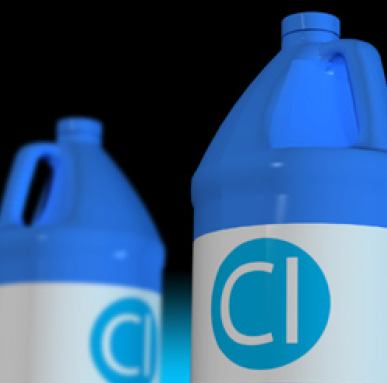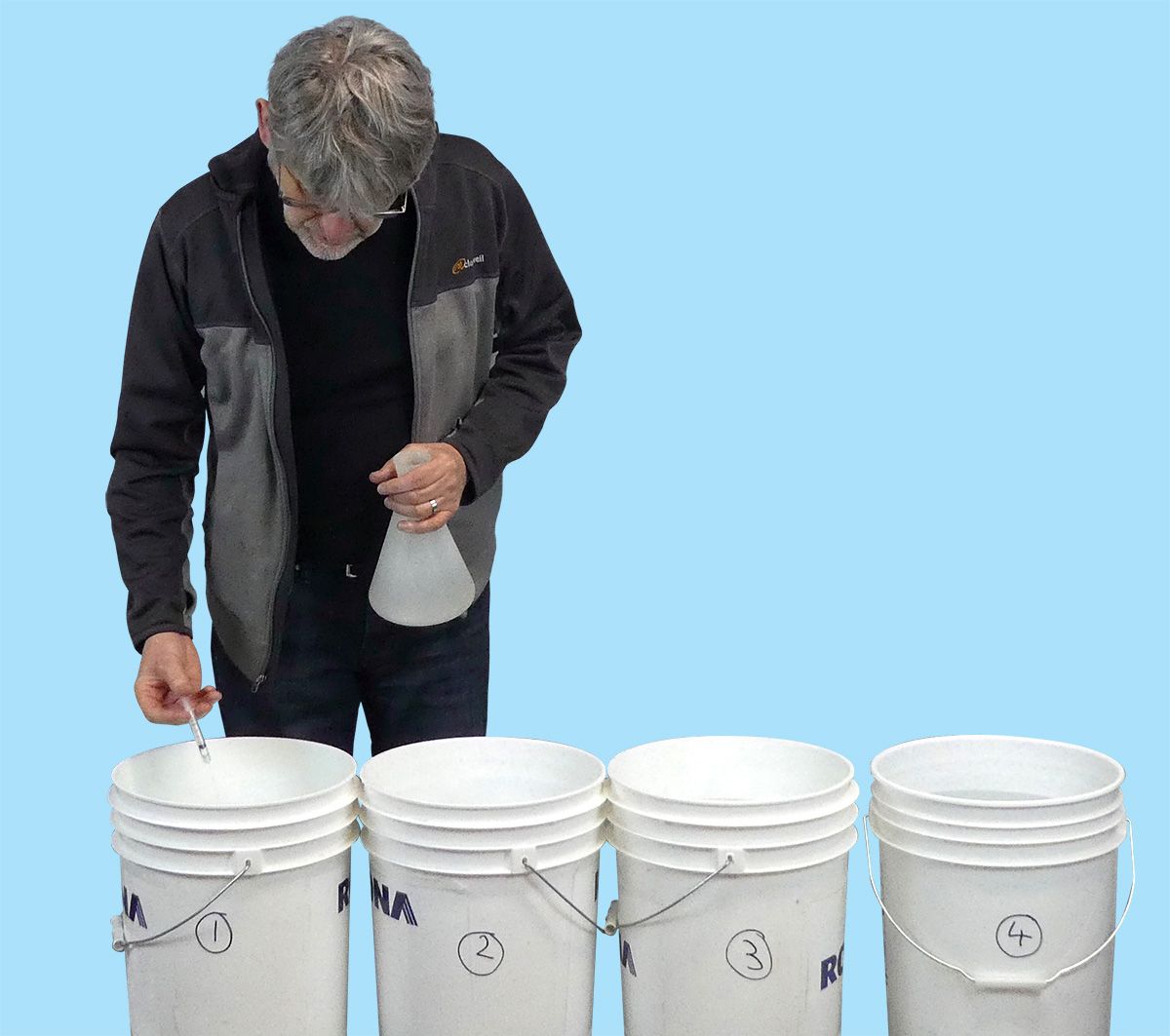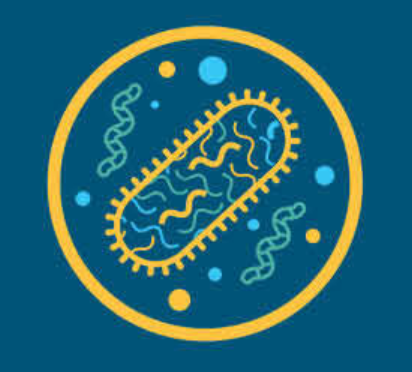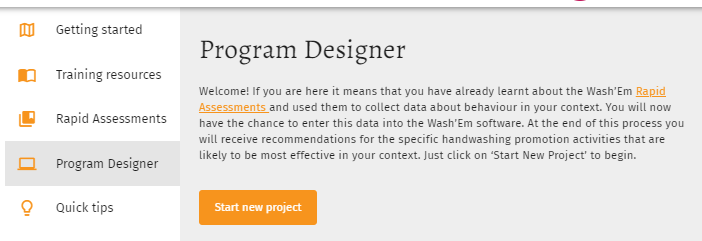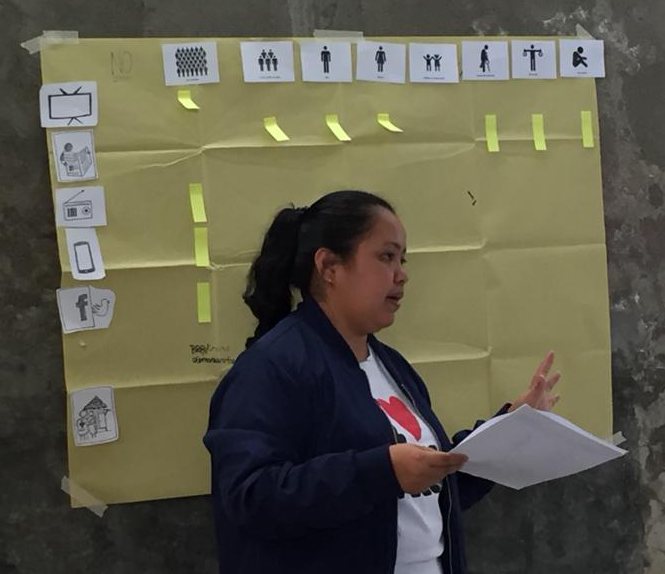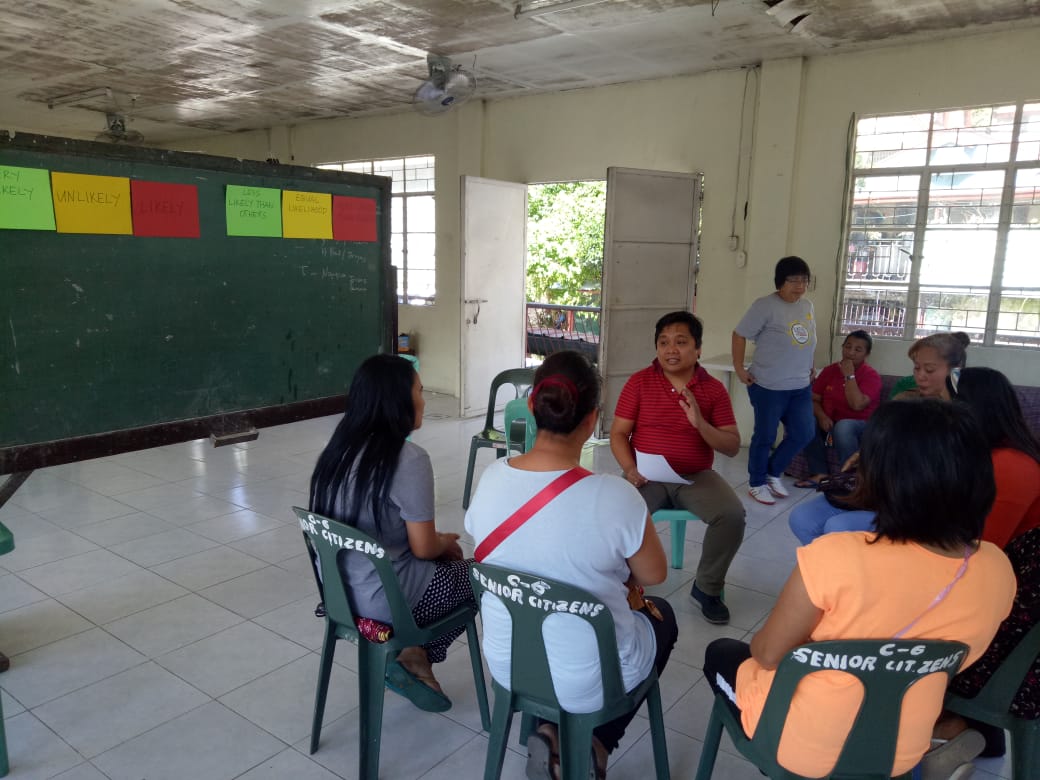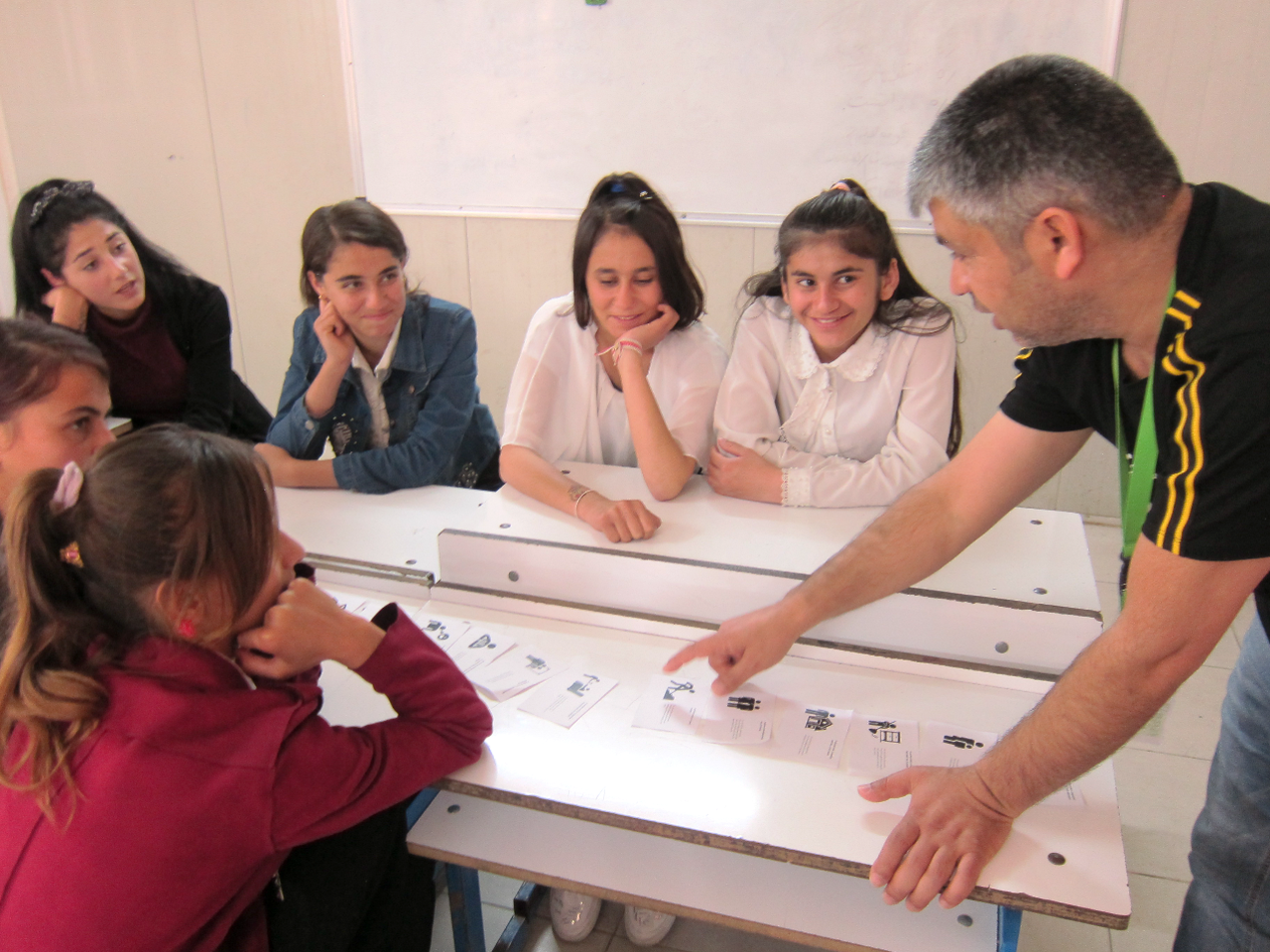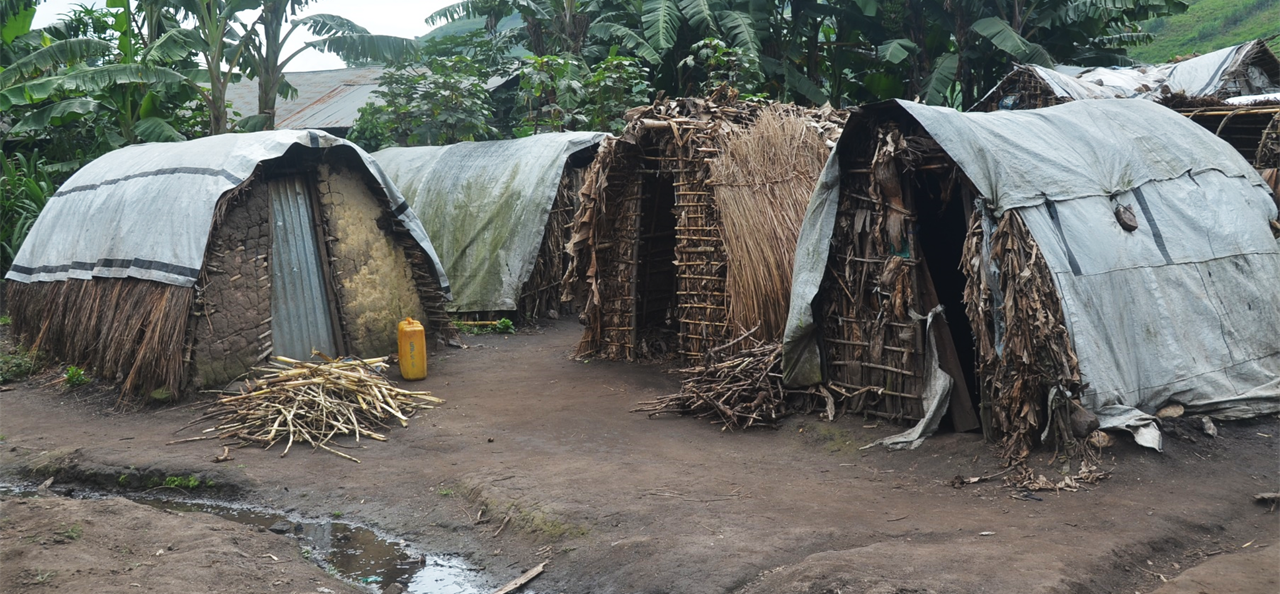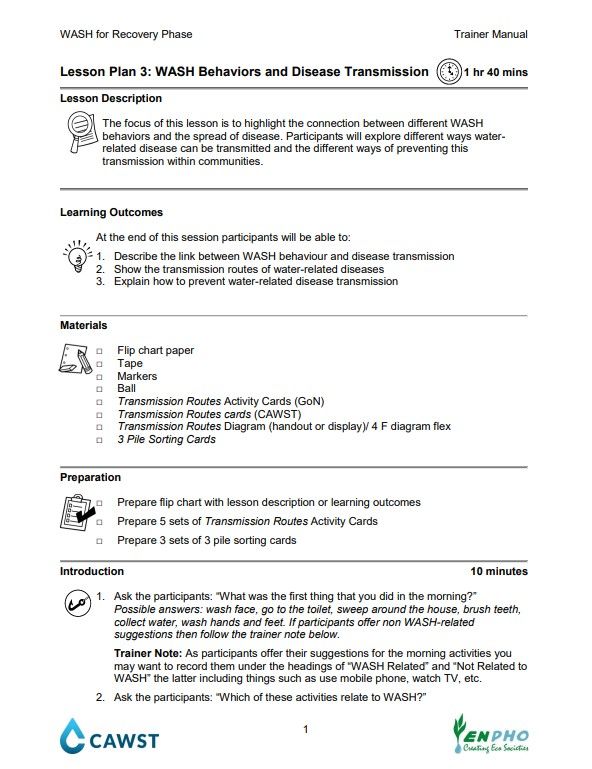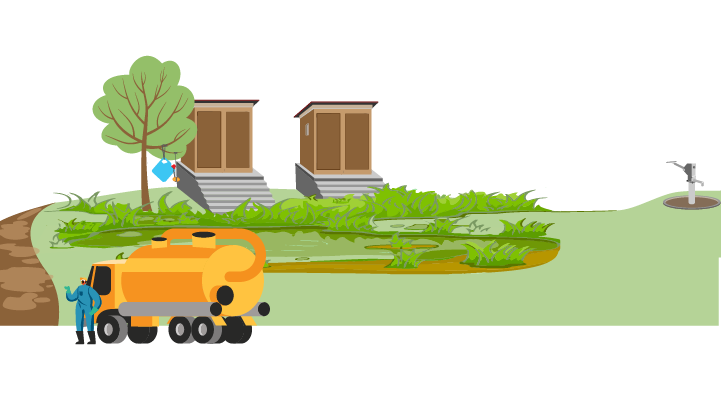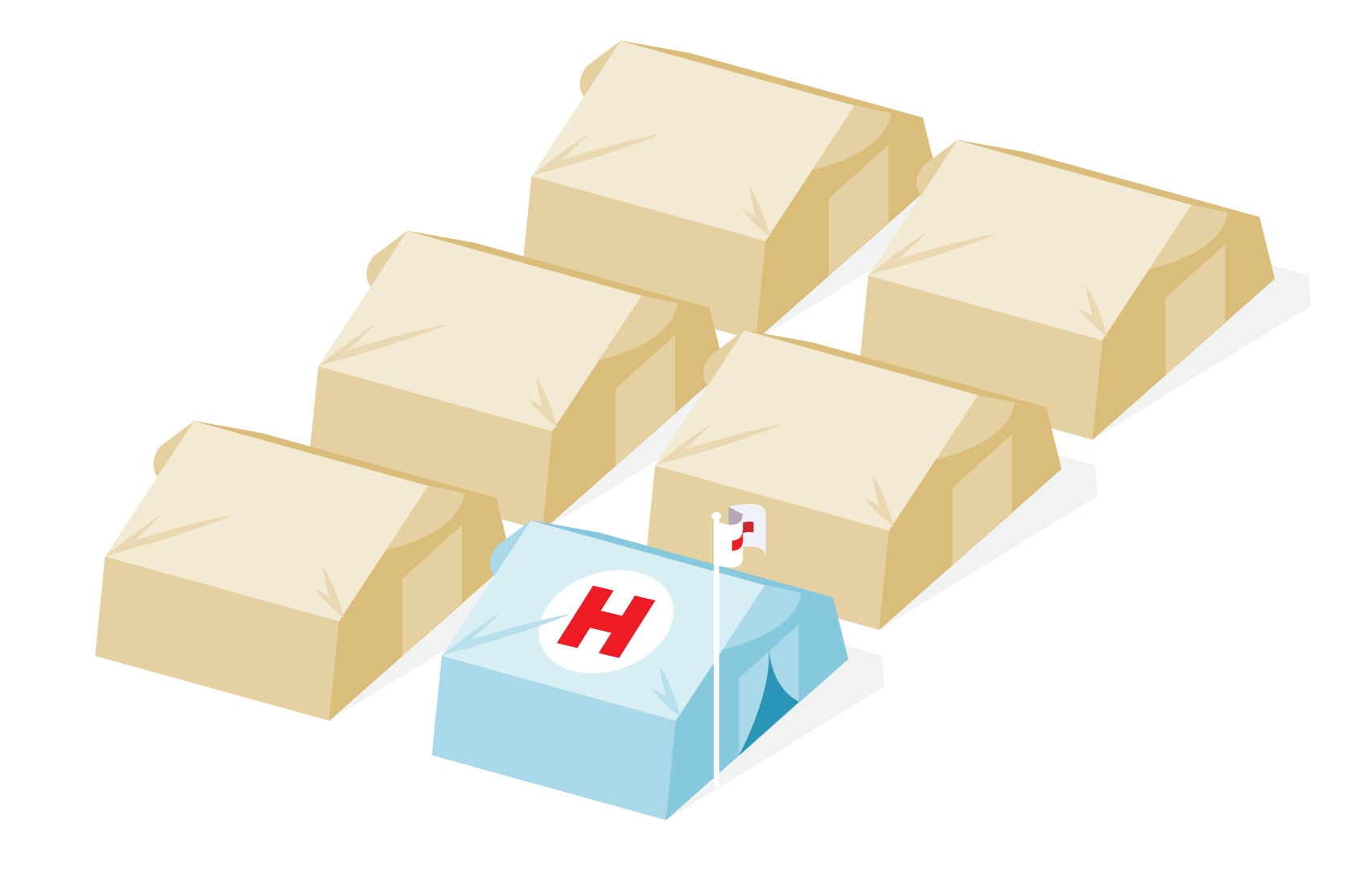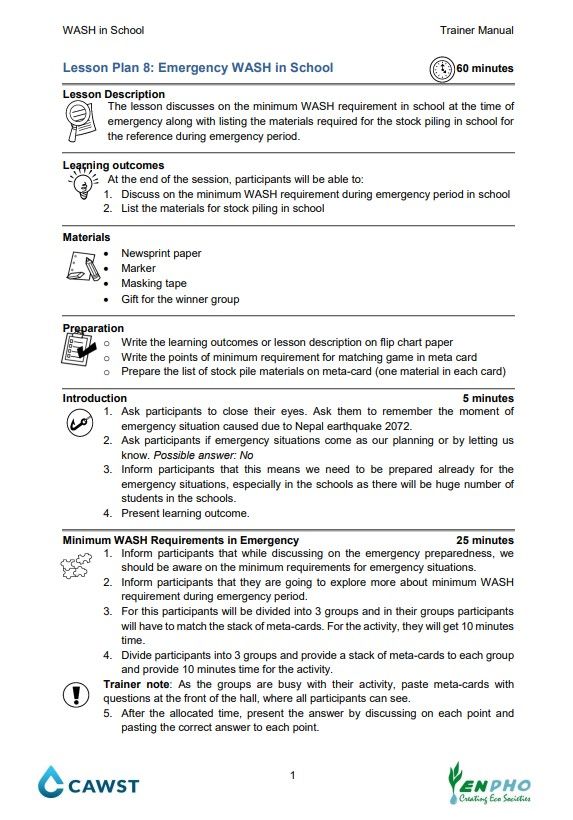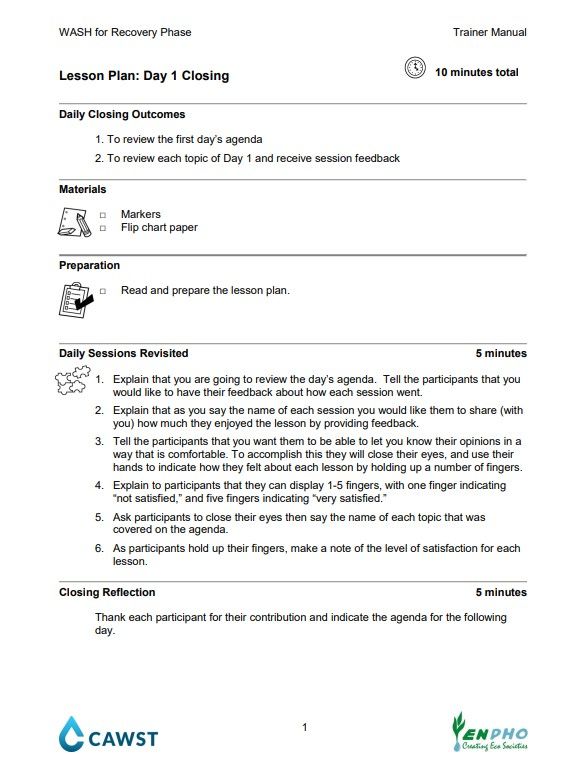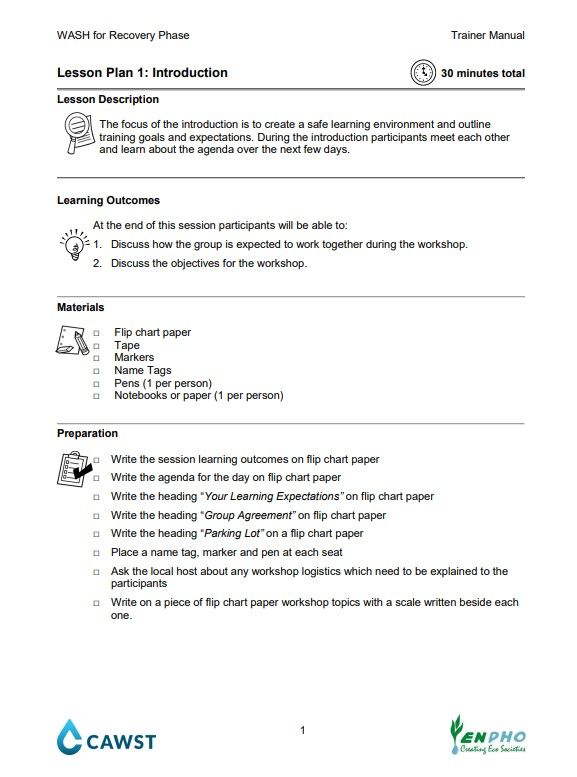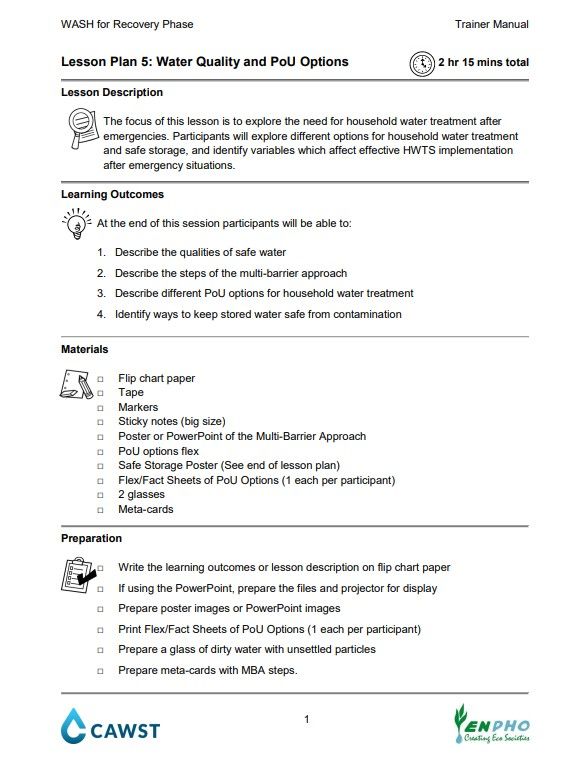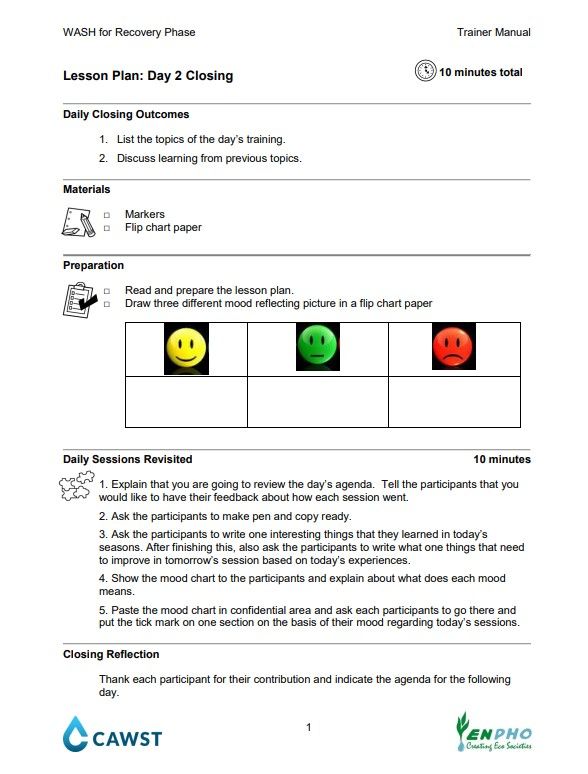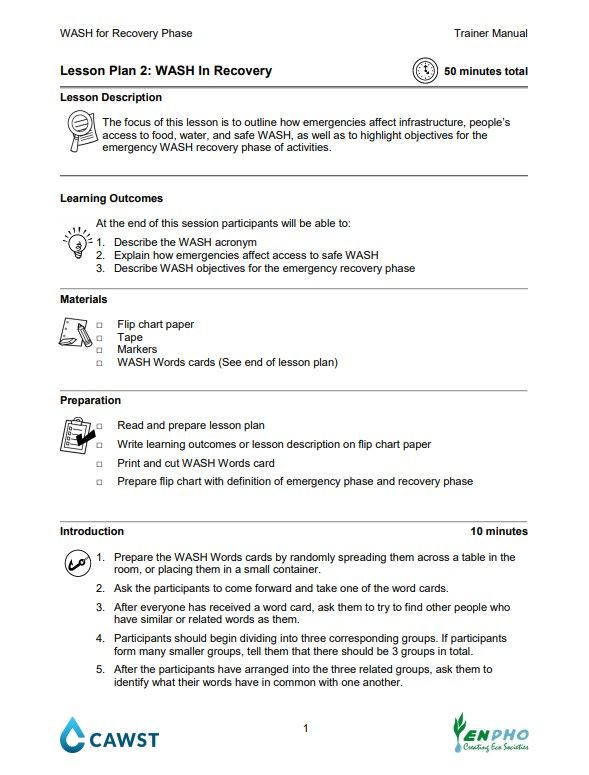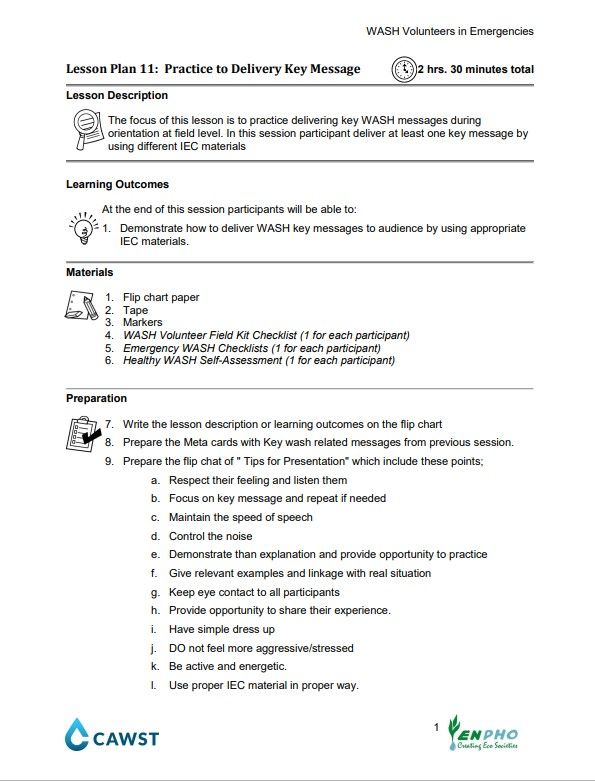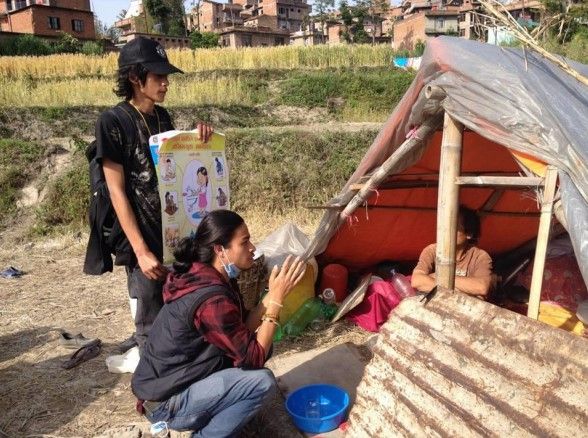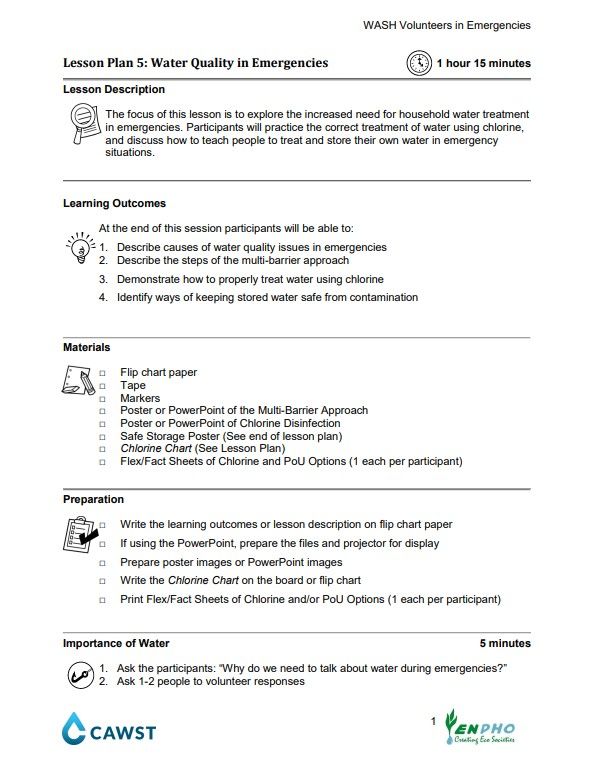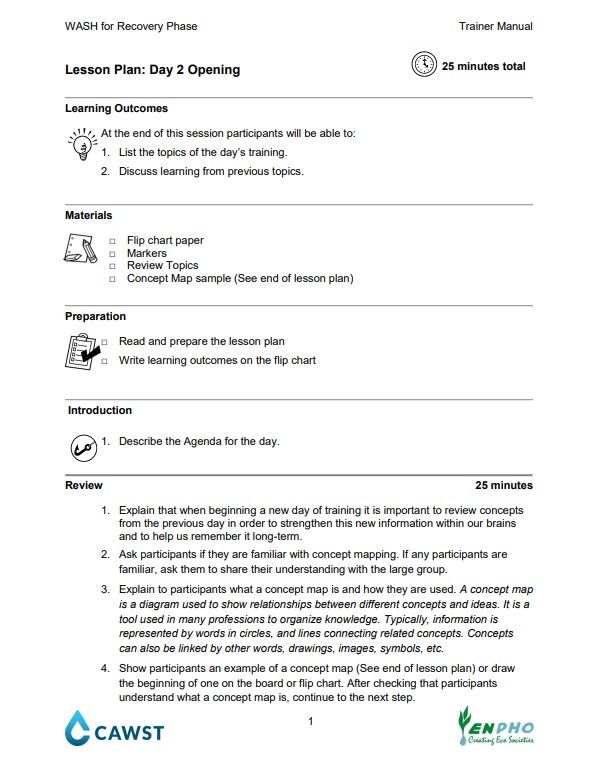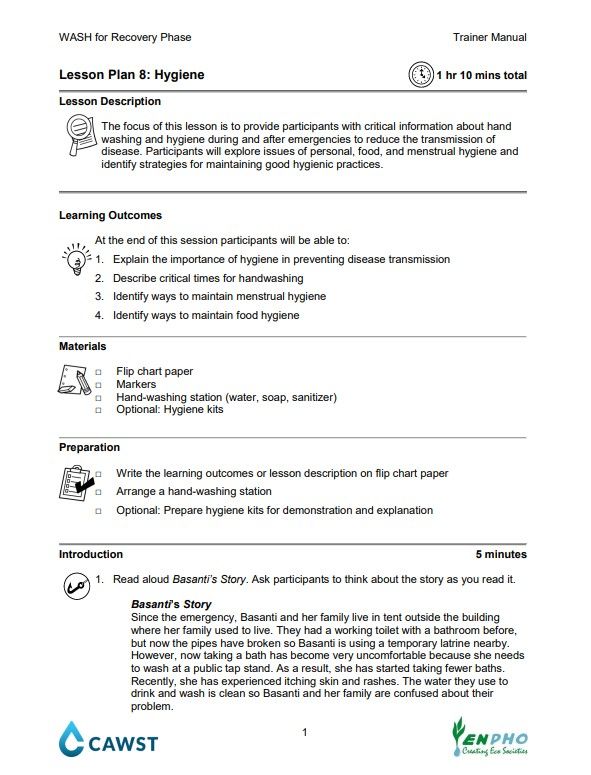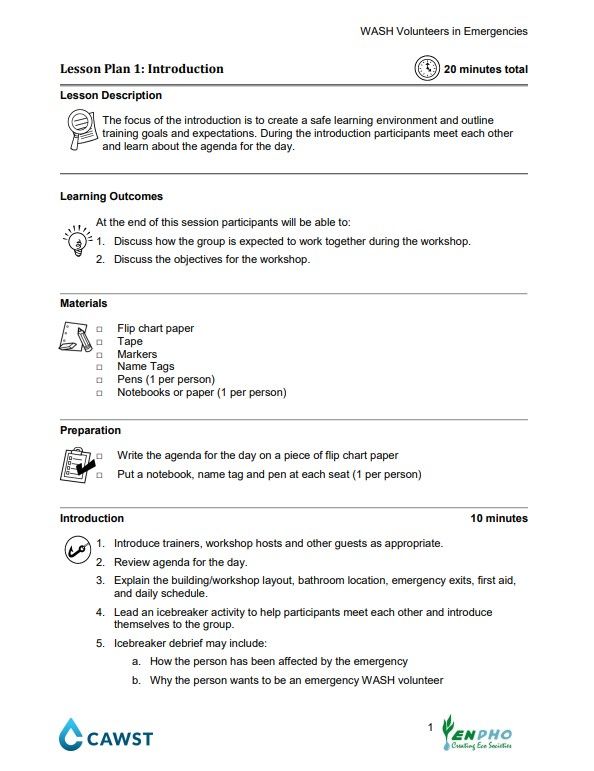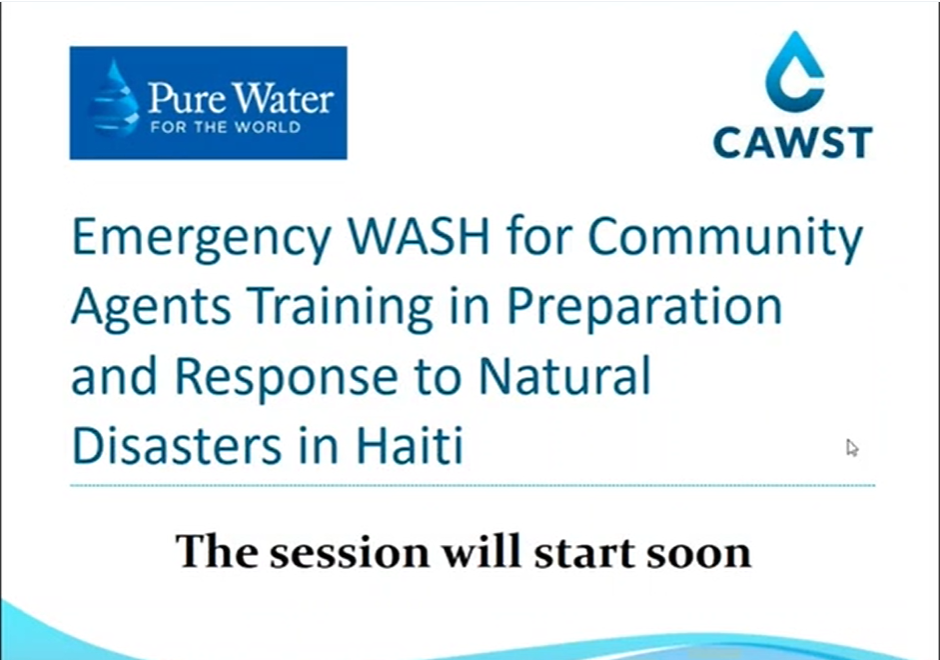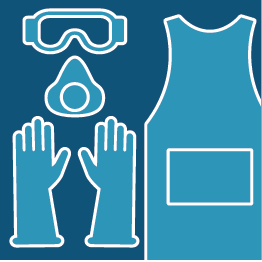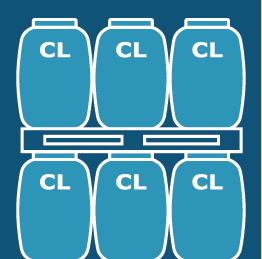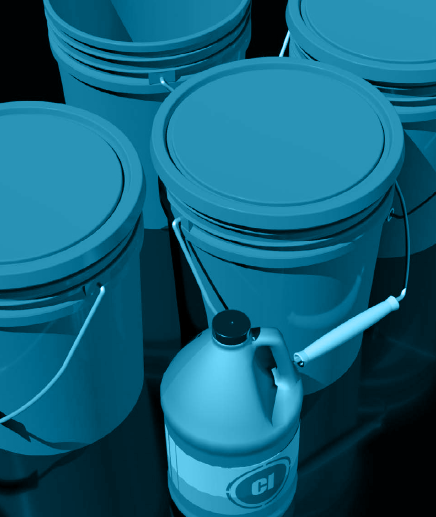Explorar WASH en emergencias
Calculadora de dosis de cloro: cloración por lotes del agua de consumo
Esta calculadora le permite determinar la cantidad de cloro necesaria para preparar una solución al 1% y la cantidad de solución al 1% necesaria para desinfectar un lote de agua de consumo.
Idiomas
inglés
francés
español
árabe
portugués
Verificar antes de desinfectar: situación de práctica de la cloración por lotes
La turbidez, el pH y la temperatura influyen en la velocidad y la eficacia con las que los productos de cloro desinfectan el agua. Póngase a prueba con esta situación de práctica en la que gestionará el agua recibida en un campamento humanitario; seleccione y evalúe los análisis de los parámetros del agua y conozca de qué forma afectan la dosis de cloro y el tiempo de contacto.
Idiomas
inglés
francés
español
árabe
portugués
Colección sobre análisis de la calidad del agua de consumo
Colección de herramientas y guías prácticas para ayudar a trabajadores del sector humanitario y de desarrollo a analizar la calidad del agua en el terreno.
Idiomas
inglés
francés
español
árabe
portugués
Cómo preparar una solución de cloro al 1%
Siga esta guía para preparar una solución de cloro al 1% que pueda usarse para la prueba Horrocks modificada y para desinfectar el suministro de agua.
Idiomas
inglés
árabe
francés
español
Usar la prueba Horrocks modificada para calcular la dosis eficaz de cloro
La prueba Horrocks modificada es un método que permite calcular la dosis de cloro correcta para una cantidad conocida de agua. Vea como Peter Thomson, director principal de CAWST, realiza la prueba Horrocks para calcular la dosis correcta de cloro para un lote de agua de consumo.
Idiomas
inglés
español
francés
árabe
Infografía: ¿Está protegiendo a los usuarios contra la biopelícula?
Use esta infografía para concientizar sobre la biopelícula, la amenaza invisible que acecha en los recipientes de agua de consumo. Este afiche explica qué es la biopelícula, el peligro que representa, los factores de riesgo que pueden originarla y cómo evitarla.
Idiomas
inglés
francés
español
árabe
hindi
Conozca el tratamiento del agua a nivel domiciliario
"¿Se pregunta cómo puede proporcionar agua potable a hogares, escuelas y clínicas de su comunidad? El tratamiento del agua a nivel domiciliario y su almacenamiento seguro (TANDAS) es una solución simple y eficaz. ¡Vea aquí todos los conceptos básicos para comenzar!"
Idiomas
inglés
español
francés
árabe
hindi
Wash'Em: Uso del programa informático Wash'Em
En este módulo, aprenderá cómo navegar por el sitio web de Wash'Em y utilizar el diseñador de programas para generar recomendaciones.
Idiomas
inglés
Wash'Em: Logística
En este módulo, se destacan todos los preparativos que deberá realizar antes de visitar la comunidad.
Idiomas
inglés
Wash'Em: Puntos de contacto
Esta herramienta le servirá de ayuda para identificar canales de comunicación, a fin de priorizar cuáles son los que tienen más probabilidades de ser eficaces para llegar a la población.
Idiomas
inglés
Wash'Em: Percepción de las enfermedades
La herramienta "Percepción de las enfermedades" ayuda a comprender qué opinan las personas sobre la enfermedad que a usted le interesa.
Idiomas
inglés
Wash'Em: Motivos
La herramienta "Motivos" lo ayudará a identificar qué cuestiones están impulsando u obstaculizando el comportamiento con respecto al lavado de manos en su contexto.
Idiomas
inglés
Wash'Em: El contexto
Para los agentes humanitarios que no están trabajando en una situación de crisis hoy en día, este módulo de aprendizaje virtual ofrece tres contextos realistas para practicar.
Idiomas
inglés
WASH Behaviors and Disease Transmission - Lesson Plan (WASH-R Nepal)
The focus of this lesson is to highlight the connection between different WASH behaviors and the spread of disease. Participants will explore different ways water-related disease can be transmitted and the different ways of preventing this transmission within communities.
Idiomas
inglés
Emplazamiento de las letrinas y acceso a ellas
Este módulo lo guiará por las cuestiones importantes que debe tener en cuenta al emplazar una letrina, centrándose en la accesibilidad desde el punto de vista del vaciador.
Idiomas
inglés
español
francés
árabe
Desafío de cambio de hábitos
Desafíese a cambiar los hábitos de higiene relacionados con la transmisión del cólera en esta situación simulada.
Idiomas
inglés
español
francés
árabe
WASH in Schools (WiS Nepal) Workshop
This collection is intended to support people who facilitate WASH in School. It is based on the practical experience of the Environment and Public Health Organization (ENPHO) and the Centre for Affordable Water and Sanitation Technology (CAWST). It has been developed specifically for the context of Nepal.
Idiomas
inglés
Emergency WASH for Volunteers (E-WASH Nepal) Workshop
This collection is for trainers who are interested in delivering training on Emergency WASH for volunteers in the context of Nepal. It was developed following the 2015 earthquake in Nepal. It includes lesson plans, agendas, and guidance on training delivery.
Idiomas
inglés
WASH for Recovery (WASH-R Nepal) Workshop
This workshop is intended to support people who facilitate WASH awareness workshops. It is based on the practical experience of the Environment and Public Health Organization (ENPHO) and the Centre for Affordable Water and Sanitation Technology (CAWST). It has been developed specifically for the context of Nepal. The lessons are for WASH promoters and work well for participants with low levels of literacy. Each lesson comes with the materials needed or instructions on how to build the necessary materials.
Idiomas
inglés
Emergency WASH - Lesson Plan (WiS Nepal)
The lesson discusses on the minimum WASH requirement in school at the time of emergency along with listing the materials required for the stock piling in school for the reference during emergency period.
Idiomas
inglés
Aprenda sobre el Tratamiento del agua en contextos de emergencia
Colección de herramientas cortas de aprendizaje virtual y guías prácticas para ayudar a los técnicos del agua a tratar, desinfectar y gestionar el agua de consumo de manera segura en el terreno.
Idiomas
inglés
francés
español
árabe
portugués
hindi
Aprenda sobre el Cambio de Hábitos
En esta colección encontrará herramientas cortas de aprendizaje virtual y guías prácticas que le ayudarán a incorporar el cambio de hábitos en el diseño de programas de WASH.
Idiomas
inglés
español
francés
árabe
Aprenda sobre saneamiento en contextos de emergencia
Colección de herramientas cortas de aprendizaje virtual y guías prácticas para orientar a los agentes de saneamiento en lo relativo al vaciado, el transporte y el tratamiento/eliminación de lodos fecales (gestión de lodos fecales) adecuados para contextos de acción humanitaria.
Idiomas
inglés
español
francés
árabe
Emergency Hygiene - Lesson Plan (E-WASH Nepal)
The focus of this lesson is to provide participants with critical information about hand washing and hygiene during emergencies to prevent the spread of disease.
Idiomas
inglés
Day 1 Closing - Lesson Plan (WASH-R Nepal)
This lesson plan contains a review for day one of the workshop.
Idiomas
inglés
Introduction - Lesson Plan (WASH-R Nepal)
The focus of the introduction is to create a safe learning environment and outline training goals and expectations. During the introduction participants meet each other and learn about the agenda over the next few days.
Idiomas
inglés
Coordinating for Support - Lesson Plan (E-WASH Nepal)
The focus of this lesson is to provide participants with information on organizations working in the disaster affected area, support these organizations are providing, and contact information to reach their services.
Idiomas
inglés
Water Quality and PoU Options - Lesson Plan (WASH-R Nepal)
The focus of this lesson is to explore the need for household water treatment after emergencies. Participants will explore different options for household water treatment and safe storage, and identify variables which affect effective HWTS implementation after emergency situations.
Idiomas
inglés
Working with People in Emergencies - Lesson Plan (E-WASH Nepal)
The focus of this lesson is to describe the current and ongoing goals of the emergency response effort, how an emergency WASH volunteer contributes to those efforts, as well as clarifies scope for the volunteer role. Participants will explore communication techniques for interacting with disaster-affected people so they are equipped with the tools they need while working in communities or in temporary relief sites.
Idiomas
inglés
Day 2 Opening - Lesson Plan (E-WASH Nepal)
This lesson plan contains a morning review from day one of the workshop. The review activities allow participants an opportunity to practice what they learned the day before.
Idiomas
inglés
WASH for Recovery Nepal Trainer Manual
This manual is for trainers who are interested in delivering training on WASH for Recovery in the context of Nepal. It was developed following the 2015 earthquake in Nepal. It includes lesson plans, agendas, and guidance on training delivery.
Idiomas
inglés
Day 2 Closing - Lesson Plan (WASH-R Nepal)
This is a lesson plan for the WASH for Recovery Nepal workshop about how to review the concepts covered in Day 2.
Idiomas
inglés
WASH in Recovery - Lesson Plan (WASH-R Nepal)
The focus of this lesson is to outline how emergencies affect infrastructure, people’s access to food, water, and safe WASH, as well as to highlight objectives for the emergency WASH recovery phase of activities.
Idiomas
inglés
Waste Management - Lesson Plan (WASH-R Nepal)
The focus of this lesson is to outline important considerations for waste management after emergency situations. Participants will discuss the increased importance of sanitation as disaster relief transitions to recovery, and explore strategies for the successful management of sanitation issues.
Idiomas
inglés
Coordinating for Recovery Activities - Lesson Plan (WASH-R Nepal)
The focus of this lesson is to provide participants with information on organizations working in areas that were affected by the disaster, the support these organizations are providing to ongoing recovery activities, and contact information to reach their services.
Idiomas
inglés
Practice Delivering Key Messages - Lesson Plan (E-WASH Nepal)
The focus of this lesson is to practice delivering key WASH messages during orientation at field level. In this session participant deliver at least one key message by using different IEC materials.
Idiomas
inglés
WASH in Emergencies - Lesson Plan (E-WASH Nepal)
The focus of this lesson is to outline how emergencies affect infrastructure, people’s access to food, water, and safe WASH, as well as to highlight the connection between emergencies and the increased risk of communicable disease in affected areas.
Idiomas
inglés
Emergency WASH for Volunteers Nepal Trainer Manual
This manual is for trainers who are interested in delivering training on Emergency WASH for volunteers in the context of Nepal. It was developed following the 2015 earthquake in Nepal. It includes lesson plans, agendas, and guidance on training delivery.
Idiomas
inglés
Water Quality in Emergencies - Lesson Plan (E-WASH Nepal)
The focus of this lesson is to explore the increased need for household water treatment in emergencies. Participants will practice the correct treatment of water using chlorine, and discuss how to teach people to treat and store their own water in emergency situations.
Idiomas
inglés
Day 2 Opening - Lesson Plan (WASH-R Nepal)
This lesson plan contains a morning review for day one of the workshop. The review activities allow participants an opportunity to practice what they learned the day before.
Idiomas
inglés
Key WASH Messages for Emergencies - Lesson Plan (E-WASH Nepal)
The focus of this lesson is to practice delivering key WASH messages during orientation at field level. In this session participant deliver at least one key message by using different IEC materials.
Idiomas
inglés
Hygiene - Lesson Plan (WASH-R Nepal)
The focus of this lesson is to provide participants with critical information about hand washing and hygiene during and after emergencies to reduce the transmission of disease. Participants will explore issues of personal, food, and menstrual hygiene and identify strategies for maintaining good hygienic practices.
Idiomas
inglés
Introduction - Lesson Plan (E-WASH Nepal)
The focus of the introduction is to create a safe learning environment and outline training goals and expectations. During the introduction participants meet each other and learn about the agenda for the day.
Idiomas
inglés
Emergency Sanitation - Lesson Plan (E-WASH Nepal)
The focus of this lesson is to outline the important considerations for excreta management and temporary latrine siting and construction during emergency situations. Participants will discuss the increased importance of sanitation during disasters and select appropriate technologies for temporary disaster relief.
Idiomas
inglés
Development and Delivery: Emergency WASH for Community Agents Training in Preparation and Response to Natural Disasters in Haiti
The presentation that will be delivered will speak about the WASH context in Haiti and how natural disasters have shaped Haiti’s access to safe water and sanitation. WASH Training and Consulting Services at Pure Water for the World in 2015 were able to co-develop an EWASH (Emergency WASH) training for CHPs during times of emergency. The presenter will speak about why emergency situations are different than other contexts and how this context presents difficulties in terms of delivering effective WASH solutions. The presentation will cover three recent natural disasters that struck Haiti (Earthquake 2010, Hurricane Mathew, Hurricane Irma) and how Pure Water for the World responded. The presentation will emphasize the impact that education can have after or before a disaster and how this differs from a direct on the ground response. The presentation will also cover why we chose to develop this training and what our goals were for the new workshop and how it is evolving. This presentation will mainly focus on our recent response to Hurricane Irma where we were able to deliver the workshop two times the week following the hurricane once in Port au Prince and then after in Cap Haitien where flooding and heavy rains were most prevalent. Facilitator: Andrew Scott Coco has been traveling to Haiti since 2011, where his mother was a medical volunteer after the 2010 earthquake. She eventually began working for Pure Water for the World shortly thereafter, while Andrew was studying Environmental Studies at the University of Vermont with a degree focus on Sustainability studies. Andrew has subsequently volunteered with Pure Water for the World during his school breaks and summer vacation since 2012. Over time, Scott found that all his course work and school focus were about Haiti: all the classes, papers, and degree track tied back into his ongoing experience in Haiti. He secured an internship with Pure Water for the World working in the Water Quality Testing laboratory in 2013.
Idiomas
inglés
Diarrheal Disease Response - Lesson Plan (WASH-R Nepal)
The focus of this lesson is to explore different diarrheal diseases present within communities and to identify ways of responding to them. Participants will discuss effective measures for responding to the presence of diarrheal disease and demonstrate how to effectively prepare oral rehydration solution in an emergency response context.
Idiomas
inglés
Disease Transmission and Blocking - Lesson Plan (E-WASH Nepal)
The focus of this lesson is for participants to discuss the connection between the environment and the spread of disease during emergencies. Participants will explore transmission routes of water-related diseases as well as ways to prevent these diseases from spreading in disaster affected areas.
Idiomas
inglés
Workshop Closing - Lesson Plan (E-WASH Nepal)
The focus of this lesson is to evaluate the information covered in the workshop and provide feedback on the training. Participants will also receive information on how to access additional support or training as an emergency WASH volunteer.
Idiomas
inglés
Plan de lección: Incentivación del uso de letrinas (WASH-R Nepal)
El objetivo de esta lección es describir consideraciones importantes para el uso de letrinas durante y después de situaciones de emergencia. Los participantes debatirán sobre la importancia cada vez mayor que tiene el saneamiento al momento de pasar del socorro en casos de desastre a la recuperación, y explorarán estrategias para el manejo exitoso de los problemas de saneamiento.
Idiomas
inglés
Manipulación segura de los productos de cloro
Siga las directrices de este afiche para almacenar y transportar los productos de cloro de forma segura. Es ideal para imprimir y pegar en los lugares en los que se manipulan y almacenan productos de cloro.
Idiomas
inglés
francés
español
árabe
Almacenamiento seguro de los productos de cloro
Siga las directrices de este afiche para almacenar y transportar los productos de cloro de forma segura. Es ideal para imprimir y pegar en los lugares en los que se manipulan y almacenan productos de cloro.
Idiomas
inglés
español
francés
árabe
Calcule la dosis de cloro: instrucciones de la prueba Horrocks modificada
Esta guía contiene instrucciones para realizar la prueba Horrocks modificada. La prueba se utiliza para hallar una dosis de cloro eficaz que sirva para la cloración por lotes del agua de consumo.
Idiomas
inglés
español
francés
árabe
Verificar antes de desinfectar: turbidez, pH y temperatura al clorar agua de consumo
La turbidez, el pH y la temperatura influyen en la velocidad y eficacia con las que los productos de cloro desinfectan el agua. Use esta guía para determinar la manera en que estos parámetros afectan la dosis de cloro y el tiempo de contacto.
Idiomas
inglés
árabe
francés
español
Learn about Wash'Em
The Wash’Em process involves using 5 rapid assessment tools to understand handwashing behaviours during a crisis. You then enter the findings into the Wash’Em software for tailored program recommendations.
Idiomas
inglés
Acerca de CAWST
CAWST es una organización benéfica y una firma autorizada de ingeniería de Canadá. Abordamos la necesidad mundial de agua potable y saneamiento mediante el desarrollo de habilidades y conocimientos en lo que respecta a soluciones domésticas que las personas pueden implementar por su cuenta.
